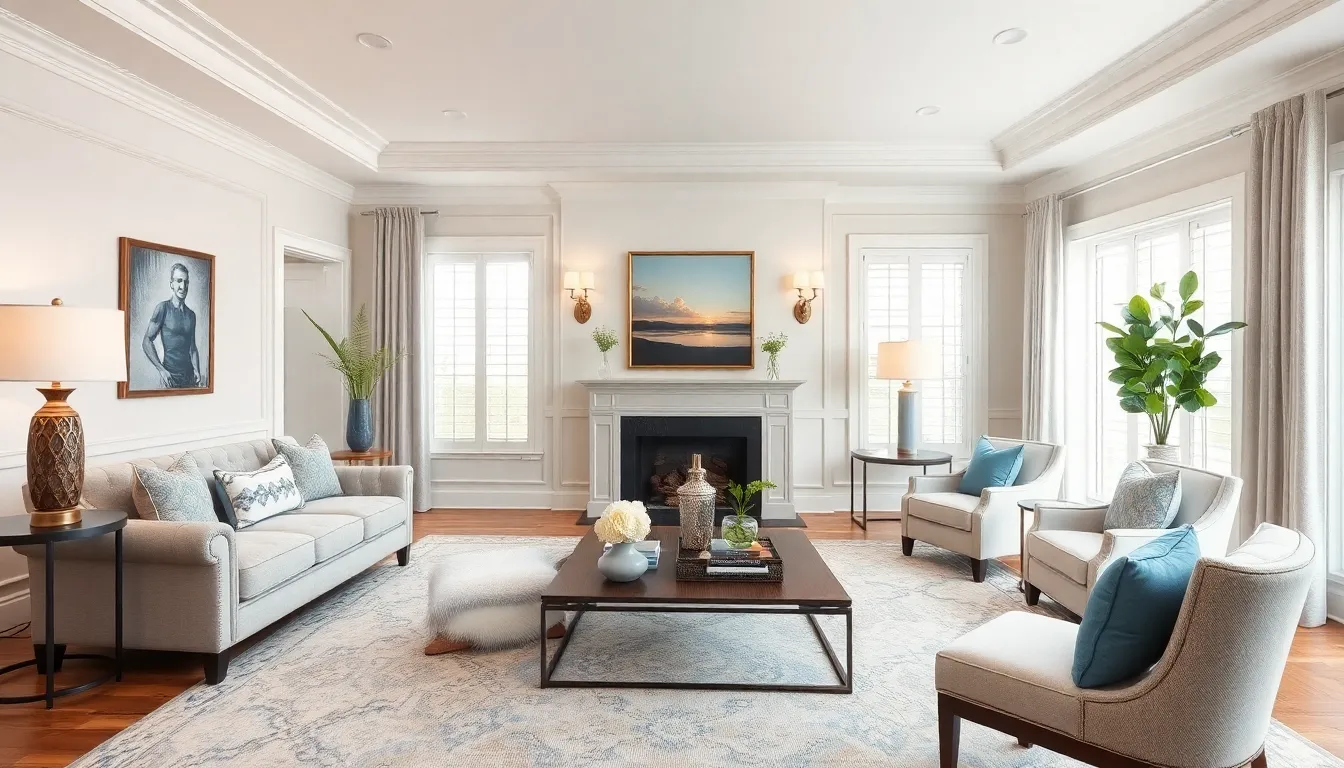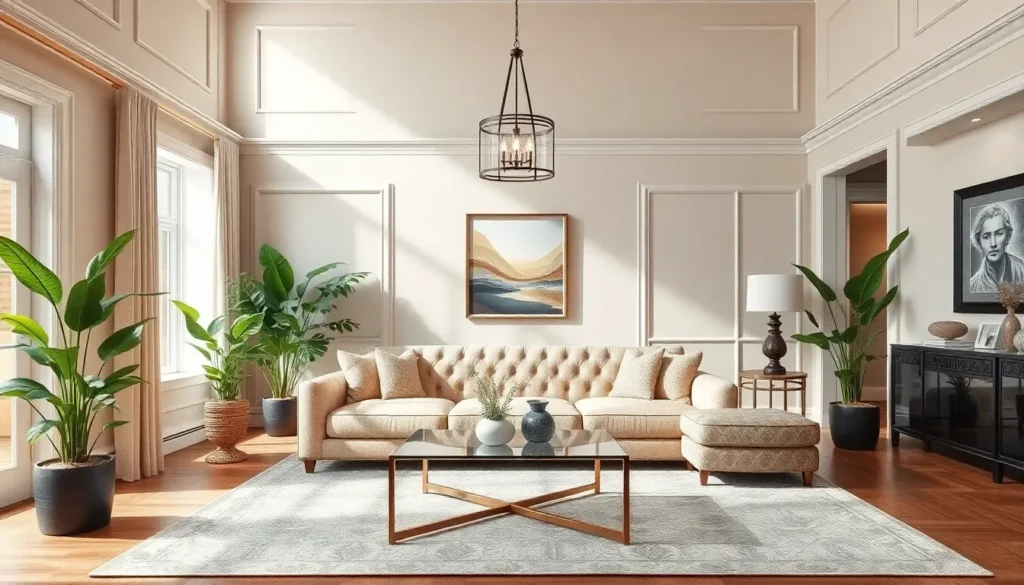Transitional home design is where traditional charm meets modern flair, creating spaces that feel both timeless and fresh. Imagine walking into a room that seamlessly blends classic elegance with contemporary comfort. It’s like wearing a tuxedo with sneakers—stylish yet relaxed.
Transitional Home Design
Transitional home design seamlessly merges traditional and contemporary styles, creating inviting spaces. This approach emphasizes clean lines and functional layouts, blending elegance with comfort. The use of neutral color palettes unifies different design elements while allowing for personal expression through decor.
Texture plays a critical role in transitional spaces. Mixing materials like wood, metal, and fabric adds depth and visual interest. Furnishings often include a mix of classic and modern pieces, providing versatility that reflects individual tastes.
Lighting fixtures contribute significantly to the overall ambiance. Pendant lights, chandeliers, and understated lamps work together to create a warm and welcoming environment. Each fixture can serve as a statement piece without overwhelming the aesthetic.
Artwork and accessories enhance the transitional design, bridging the gap between styles. Choosing carefully curated pieces fosters a cohesive look. Plants and greenery introduce a sense of life, softening hard edges and bringing freshness.
Functionality remains a priority in transitional home design. Open floor plans encourage a natural flow between spaces, making them ideal for everyday living and entertaining. Storage solutions often incorporate built-in designs, promoting organization while maintaining visual harmony.
Ultimately, transitional home design offers a flexible framework for personalized expression. Homeowners can adapt the style to suit their preferences while enjoying a balanced, sophisticated atmosphere.
Key Characteristics

Transitional home design is distinguished by its harmonious blending of styles and colors. This cohesion creates inviting and functional spaces.
Blend of Styles
This design style fuses traditional elegance with contemporary simplicity. Classic furnishings, such as tufted sofas, mix seamlessly with modern pieces like sleek coffee tables. Accessories play a crucial role, with items from both eras showcased together, enhancing visual interest. Refined details, like moldings paired with minimalist decor, emphasize balanced aesthetics. Accessibility to multiple design elements invites personalized expression, appealing to various tastes. Versatility allows homeowners to tailor their spaces without losing a cohesive look.
Neutral Color Palette
A neutral color palette serves as a unifying foundation in transitional design. Shades of beige, gray, and cream create a calming backdrop that enhances other design elements. Warm undertones foster a welcoming atmosphere, while cool tones can lend a modern touch. Accents in muted colors, like soft blues and greens, introduce subtle interest without overwhelming the space. This approach offers flexibility for adding personal decor pieces and artwork, ensuring every room reflects individual preferences. Emphasizing lightness and airiness, these hues complement the overall refined aesthetic.
Popular Elements in Transitional Design
Transitional design features a refined blend of traditional and modern elements, creating inviting and functional spaces. Key components enhance both aesthetics and comfort.
Furniture Selection
Selecting furniture in transitional design emphasizes a mix of classic and contemporary styles. Tufted sofas paired with sleek coffee tables provide a versatile and balanced look. Accent chairs often come in various shapes and textures, contributing visual interest. Choosing furniture that prioritizes both elegance and comfort ensures a welcoming environment. Complementing neutral color palettes with statement pieces introduces personality without overwhelming the space. A combination of wood, metal, and fabric materials enhances visual depth. Finally, furnishings should effortlessly flow together, allowing homeowners to express their individual tastes.
Lighting Fixtures
Lighting fixtures play a vital role in transitional design, significantly impacting ambiance. Opting for pendant lights or chandeliers can create a warm, inviting atmosphere. Choosing fixtures with sleek lines maintains a contemporary feel while honoring traditional elegance. Incorporating layered lighting enhances functionality, offering both task and ambient light. Strategically placed fixtures can highlight architectural details and artwork. Using soft bulbs lends a cozy glow, fostering a sense of comfort throughout the space. Overall, the right lighting complements the design, ensuring every room feels unified and inviting.
Benefits of Transitional Home Design
Transitional home design combines modern style with traditional elements, offering numerous advantages. This unique approach enhances living spaces with a blend of comfort, elegance, and personal expression.
Versatility
Versatility defines transitional design, allowing it to adapt easily to various preferences. Homeowners can mix classic and contemporary pieces, creating a customized look. This design style accommodates different tastes, so it works well in a variety of settings. For instance, pairing tufted sofas with sleek coffee tables establishes a balanced yet dynamic atmosphere. Adaptability allows for changes in decor without needing complete overhauls. Spaces can accommodate diverse functions, making them suitable for both relaxation and entertaining.
Timeless Appeal
Timeless appeal characterizes transitional home design, as it effortlessly marries both eras. Neutral color palettes form a calming foundation that never goes out of style. Shades like beige, gray, and cream enhance other design elements while fostering a serene ambiance. A blend of traditional elegance and modern simplicity creates lasting visual interest. This style transcends trends, ensuring homes remain stylish for years. Homeowners enjoy the ability to showcase personal tastes, as accents in muted colors add character without overwhelming the overall aesthetic.
Conclusion
Transitional home design stands as a testament to the beauty of blending styles. It creates spaces that invite comfort while maintaining elegance. By harmonizing traditional and contemporary elements, this design approach offers versatility that resonates with many homeowners.
The neutral color palettes and thoughtful textures enhance the overall aesthetic, making each room feel cohesive and inviting. With the right furnishings and decor, individuals can express their unique tastes while enjoying a timeless atmosphere.
Whether through open layouts or carefully curated accessories, transitional design fosters a sense of balance that appeals to modern sensibilities. Embracing this style allows for a home that’s not just visually appealing but also functional and welcoming.


More Stories
Home Trends and Design: Transform Your Space with the Latest Stylish Innovations
Custom Home Design Services: Transform Your Dream Home into Reality Today
Studio41 Home Design Showroom: Transform Your Space with Exceptional Design Inspiration